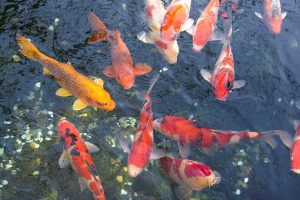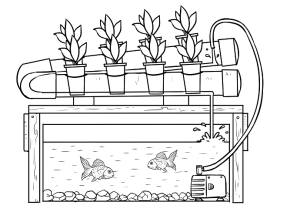Aquaculture is the captive rearing and production of fish and other aquatic animal and plant species under controlled conditions. Many aquatic species have been cultured, especially fish, crustaceans and molluscs and aquatic plants and algae. Aquaculture production methods have been developed in various regions of the world, and have thus been adapted to the specific environmental and climatic conditions in those regions.
The four major categories of aquaculture include open water systems (e.g.cages, longlines), pond culture, flow-through raceways and Recirculating Aquaculture Systems (RAS). In a RAS operation water is reused for the fish after a cleaning and a filtering process. Although a RAS is not the cheapest production system owing to its higher investment, energy and management costs, it can considerably increase productivity per unit of land and is the most efficient water-saving technology in fish farming.
A RAS is the most applicable method for the development of integrated aquaculture agriculture systems because of the possible use of by-products and the higher water nutrient concentrations for vegetable crop production. Aquaponics has been developed from the beneficial buildup of nutrients occurring in RASs and, therefore, is the prime focus of this manual.
Aquaculture is an increasingly important source of global protein production. In fact, aquaculture accounts for almost one-half of the fish eaten in the world, with aquaculture production matching capture fisheries landings for the first time in 2012. Aquaculture has the potential to decrease the pressure on the world’s fisheries and to significantly reduce the footprint of less-sustainable terrestrial animal farming systems in supplying humans with animal protein.
However, two aspects of aquaculture may be addressed to improve the sustainability of this agricultural technique. One major problem for the sustainability of aquaculture is the treatment of nutrient-rich wastewater, which is a by-product of all the aquaculture methods mentioned above. Depending on the environmental regulations set by each country, farmers must either treat or dispose of the effluent, which can be both expensive and environmentally harmful. Without treatment, the release of nutrient-rich water can lead to eutrophication and hypoxia in the watershed and localized coastal areas, as well as macroalgae overgrowth of coral reefs and other ecological and economical disturbances.
Growing plants within the effluent stream is one method of preventing its release into the environment and of obtaining additional economic benefits from crops growing with costless by-products through irrigation, artificial wetlands, and other techniques. Another sustainability concern is that aquaculture relies heavily on fishmeal as the primary fish feed. From a conservation standpoint, this is discharging one debt by incurring another, and alternative feed ingredients are an important consideration for the future of aquaculture. The majority of this publication is dedicated to reusing aquaculture effluent as a value added product.
Aquaponics:
Aquaponics is the integration of recirculating aquaculture and hydroponics in one production system. In an aquaponic unit, water from the fish tank cycles through filters, plants grow beds and then back to the fish. In the filters, the fish waste is removed from the water, first using a mechanical filter that removes the solid waste and then through a biofilter that processes the dissolved wastes.
The biofilter provides a location for bacteria to convert ammonia, which is toxic for fish, into nitrate, a more accessible nutrient for plants. This process is called nitrification. As the water (containing nitrate and other nutrients) travels through plant grow beds the plants uptake these nutrients, and finally the water returns to the fish tank purified. This process allows the fish, plants and bacteria to thrive symbiotically and to work together to create a healthy growing environment for each other, provided that the system is properly balanced.
In aquaponics, the aquaculture effluent is diverted through plant beds and not released to the environment, while at the same time the nutrients for the plants are supplied from a sustainable, cost-effective and non-chemical source. This integration removes some of the unsustainable factors of running aquaculture and hydroponic systems independently.
Beyond the benefits derived by this integration, aquaponics has shown that its plant and fish productions are comparable with hydroponics and recirculating aquaculture systems. Aquaponics can be more productive and economically feasible in certain situations, especially where land and water are limited. However, aquaponics is complicated and requires substantial start-up costs. The increased production must compensate for the higher investment costs needed to integrate the two systems.
Before committing to a large or expensive system, a full business plan considering economic, environmental, social and logistical aspects should be conducted. Although the production of fish and vegetables is the most visible output of aquaponic units, it is essential to understand that aquaponics is the management of a complete ecosystem that includes three major groups of organisms: fish, plants and bacteria.
Types of systems:
Since aquaponics uses basically the same systems as hydroponics, there aren’t many differences in how the system works, except for the added fish in the water tank(s). Drip irrigation, flood and drain, deep culture or water submerged roots, and nutrient film technique are highly compatible and customizable to merge with growing fish.
Importance of pH control in Aquaponics
pH is an important part of aquaculture. Setting it to a perfect level can be a bit confusing since there are three living organisms to care for: your plants, your fish, and the bacteria inside the water and each of them has a different pH need. A neutral pH from 6.8 to 7.2 is good for the aquaponic garden. Because of the fish waste, the pH will become acidic and you will need to use aquaponic compatible pH adjusters. If the pH level is not beneficial for the system that is too low or too high, the plants will not be able to absorb nutrients optimally and your fish will die eventually. It’s very important to monitor the pH level each day and to keep it within the neutral range.

Koi are great for your Aquaponics system. A too alkaline or too acidic pH is one of the main reasons fish or plants die, leading to gardening failure. The pH adjusters need to be specially designed for this type of growing system, otherwise, they could harm the fish. You can find these adjusters in a local aquaponic gardening supplier.
Another thing to keep in mind is the water hardness because it affects how pH will behave when trying to adjust it. Sometimes it would be necessary to also take care of the water hardness when working the pH. Fish don’t like sudden changes in pH, so when adjusting it try to lower or increase it slowly.
Fish and other aquatic animals you can grow in aquaponics:
Fish are the ones feeding your plants. The fish used in this type of aquaculture are freshwater fish, most popular being tilapia and barramundi because they tolerate better diverse water conditions and they grow fast. Trout can also be used especially for lower water temperatures. Other aquatic animals you can grow are snails and shrimps.
You can feed the fish special food you can purchase in an animal store or other foods like water lettuce and duckweed.
What vegetables you can grow in aquaponics:
In a small aquaponic based garden you can grow vegetables that don’t need heavy nutrient input. Lettuce, kale, watercress, arugula, decorative flowers, mint, herbs, okras, spring onions and leek, radishes, spinach and other small vegetables. Cabbage, tomatoes, cucumbers, beans, broccoli and cauliflower can require more nutrition and a well stocked or more advanced aquaponic system.
Avoid growing plants that need acidic or alkaline water, because those levels of pH can definitely harm the fish.
Benefits of aquaponics:
- Aquaponics is a way to grow your own fish and vegetables at the same time. You feed the fish and the fish will feed your plants through their waste output.
- There is no need to use fertilizers because the fish provide rich nutrients for the plants.
- In aquaponics, less water is used for the crops. Research has shown that aquaponic gardens use 1/10th of the water you would use for soil garden.
- Regular gardening pesticides or other chemicals can’t be used because they would harm the fish.
- This results in healthier and organic vegetables.
- You won’t experience any soil borne diseases in aquaponics as it’s totally soli-less farming.
- You can grow plants in very small space, and have a great harvest.
- Plants grow fast because they get very nutritious substances from the fish waste.
- Plants and fish production can be done in a controlled temperature environment.
- Water is used in a closed system and circulated effectively reducing the consumption and the water bills.

Important & Useful Tips on an Aquaponic Garden Setup:
- You can make your own aquaponics system and here is a simple and complete guide you can use to make one. Start small see if it’s good for you then feel free to go bigger.
- Have set a different power source as a backup. It’s vital to keep the water flowing and the oxygen pumps on.
- Make sure you feed the fish enough and let them thrive. Depletion of fish stock makes this type of cultivation impossible.
- Keep food input constant for the fish and that will result in regular fish waste you can use to feed your plants.
- Ensure your plants and fish with good aeration. Not only the plants need their roots to be oxygenated, but also, the fish and the bacteria need the water to be oxygenated. As the fish grow bigger, their oxygen needs increases and you might need to adjust accordingly.
- When you decide what plants you want to grow, pick the ones that have similar water condition needs as the fish, and you will have greater success.
- Remove some excess fish waste when necessary. Too much can harm the health of the fish.
- Keep an eye on the level of pH because as shown above, it is crucial for the garden.
- Fish tanks should be made of glass or food grade plastic.
- Avoid using any pesticide other than organic, or any other substances that can and will harm the fish or the good bacteria (vinegar, citric and/or hydrochloric acid).
Many organisations apart from the individuals are growing conscious in adopting the indoor farming techniques to actively involve in the Water Conservation & Recycling techniques that helps in dual ways of improving the water usage and farming as well. Hydromo being the Top Water and Wastewater Management Company is diversifying it’s water conservation techniques with the utmost water technologies such as setting up of Water and Wastewater Treatment Plants, Hydroponic Plants, Aquaponic Plants & Water Management.
